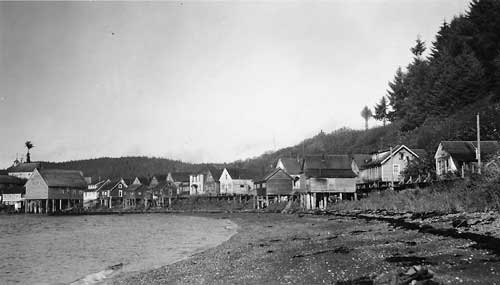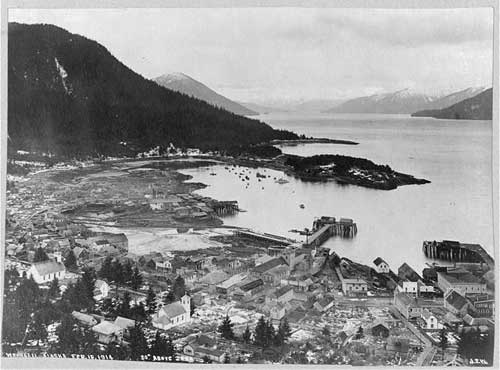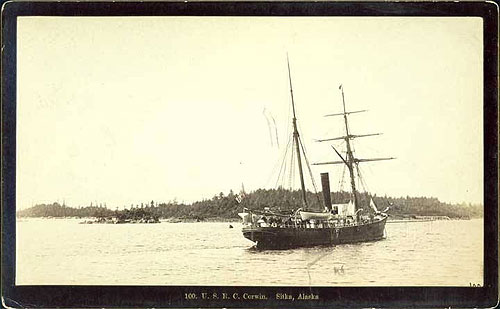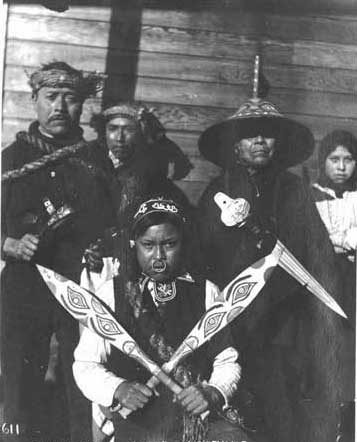 Attack was later called a 'misunderstanding' By DAVE KIFFER October 29, 2007
Even in the late 19th Century when America had been at "war" with many of the Native peoples of western North America for two generations, the shelling of Angoon was controversial. The shelling also directly led to the eventual removal of military control of the district of Alaska and the creation of a limited local government in what would eventually become the 49th state.  Garfield, Viola Edmundson, 1899- Photograph courtesy Library of Congress
In the case of the Angoon shelling the US government later disavowed the decision making that led to the bombing and called the incident a "misunderstanding." It was a misunderstanding that the village Natives say had fatal consequences. "Earlier Bombings in Kake and Wrangell" The bombing of Angoon followed a pattern the American military had established not long after the US took possession of Alaska from Russia in 1867. In January of 1869, a party of Natives from Kake decided to leave Sitka and return home. For reasons that were not recorded, the military authorities forbade them to leave and ordered the sentries to detain them. A scuffle broke out and one of the Natives was killed. Then the group of Tlingits was then allowed to return to Kake. But on their way back, the group came across two miners, Ludwig Madger and William Walker, camped in a small cove (later named Murder Cove) near Point Gardiner on Admiralty Island. The miners were killed and their remains mutilated. When word of the killings got back to Sitka, the armed vessel Saginaw under the command of Lt. Commander Meade was sent to Kake. It proceeded to shell Kake, destroying most of the buildings. It also shelled two smaller villages nearby. No Native casualties were reported, primarily because the villages had been forewarned and were evacuated. But most of their canoes were destroyed and the Kake natives were forced to disperse to other villages. It would be two decades before the village of Kake would reconstitute itself, according to information on a State Of Alaska Commerce and Economic Development website.  Forms part of: Frank and Frances Carpenter collection (Library of Congress). Gift; Mrs. W. Chapin Huntington; 1951. Photograph courtesy Library of Congress
The US Army was also involved in a shelling, later in 1869. George Thornton Emmons, a US Naval officer in Alaska from 1882 to 1899, and later one the first ethnographers to study Alaska Natives, wrote about the Wrangell incident in "The Tlingit Indians" his masterwork, which was written in the 1930s and 1940s but not published until 1991. "The shelling of Wrangell in 1869 by the Army at Fort Wrangel was ordered to enforce the surrender of an Indian named Scutdoo or Scutdor who had killed a White trader in retaliation for the wanton and unjustifiable killing of an Indian name Si-Wau by Lt. Loucks the second in command of the post," Emmons wrote. "Si Wau was drunk at the time and had bitten off part of a finger of (another soldier's) wife." Emmons noted that Scutdoo was a cousin of Si Wau and felt duty bound to kill a white to avenge the death. The Army shelled a large portion of the Indian village and then took Scutdoo's mother and another Native hostage. Scutdoo gave himself up and was tried, convicted and hanged for the murder. Emmons reported that before the execution Scutdoo expressed sorrow over the killing and said he had nothing personal against the dead trader and he hoped to meet up with him in the afterlife. "Native Was Killed on Whaling Ship" The situation that led to the Shelling of Angoon on Oct. 26, 1882 - some 13 years after the earlier incidents - began with a harpoon gun exploded on a whaling ship operated by the Northwest Trading Company which had a herring and whale reduction plant at Killisnoo, just south of the Tlingit village of Angoon on the west side of Admiralty Island facing Chatham Strait. The whaling ship was attempting to take a whale out in the Strait on Oct. 22 when the gun exploded spraying the crewmen with fragments. One struck and killed Tith Klane, a medicine man from Angoon, according to the Kootznawoo Heritage Foundation. Klane was killed and other Native crewmen took his body ashore. Then the "misunderstandings" began to occur.  Photograph courtesy Alaska State Library - Historical Collections
"If the demand (for the reparations) was not met the natives threatened to burn the company's store and buildings, destroy its boats and put to death the white prisoners," Healy reported that the Navy was told by the whaling station superintendent. Capt. E.C. Merriman, the commander of the largest navy ship in Alaska, the USS Adams, then ordered the Corwin and a whaling company tugboat called the Favorite - which was armed for the mission - to respond to the situation. Merriman later said he felt the Adams would be too large to effectively maneuver in the shallow waters near the village. Healy reported that after anchoring the white men who were being held were released "some of the ring leading Indians captured and the release of the property effected." Then Merriman - perhaps wanting to make a "statement" in the manner of the early Kake and Wrangell shellings - upped the ante, according to Healy, and demanded that the Natives turn over 400 blankets to Navy. Healy reported that the Navy threatened to destroy the village if the demand was not met. He said when the Natives didn't meet the demand (Angoon records state that the villages offered 82 blankets), some forty canoes were destroyed and the village was shelled and burned. Healy's report was further buttressed by a second report that was sent to Congress, this from William Morris, the federal revenue collector in Sitka. Morris contended that the Navy had acted appropriately. "It has been a custom for many years in this territory when an Indian has been killed by another, or by a white man for his surviving relatives to demand at the hands of the parties who injured him a certain tribute, consisting generally of blankets," Morris wrote to the Secretary of the Treasury on Oct. 28, 1882. "The Hoochenoos are a rich and warlike tribe, very insolent and saucy towards the whitesAs long as the native tribes throughout the archipelago do not feel the force and are not punished for flagrant outrages, so much the more dangerous they becomethe punishment has been most severe, but eminently most salutatory." In January, Capt. Merriman also sent a report to Congress, via the Secretary of the Treasury, Charles Folger. Merriman's account generally followed the same trajectory as the reports of Healy and Morris, but added interesting details regarding the "negotiations" with the Native leaders , particularly regarding a meeting with Angoon leaders "Kenalkos" and "Loginon Jake" that happened after the village was burned. "I told them in substance what I had said before, that while the government felt friendly to them and wanted them to till the soil and fish and hunt, and would protect them in pursuing their peaceful avocations, it would put down with a rigorous hand any attempt to seize and injure white men or their property," Merriman wrote. "They replied that they would never attempt to do anything of the kind again; that the old men and chiefs had tried to restrain the young men, but were unable to do so; that as a lesson to the young men and the squaws, they were glad that I had burned the village." Merriman also reported that not all the houses or the canoes had been destroyed, only the ones belonging to the villagers who had not cooperated with the Navy. "They Left Us Homeless On the Beach" Naturally, the tribal memory at Angoon differs from the official version of the US military. In 1982, the 100th anniversary of the shelling, Angoon tribal elders agreed that the eye witness of account of Billy Jones, who was 13 when the attack occurred, should be the basis of the Angoon story, according to "In Commemoration" the official publication of the Kootznoowoo Heritage Foundation on the centennial anniversary,
Jones, a nephew of Tith Klane, told his story to pioneering Alaskan anthropologist Frederica de Laguna in 1949 and 1950 when he was in early 70s. Jones told de Laguna that the villagers didn't have any warning about the arrival of the Navy ships. They were on the beach putting up the fall herring run when the "huge black ship" steamed into Kootznahoo Inlet. Soon, white men came ashore and took two of the tribal leaders back to the ship with them. Jones said the white men were shouting but that he and most of the Angoon Natives couldn't understand what they were saying. A short time later, more "men in uniforms" came back ashore and began gathering all the Angoon canoes together. Then they began to smash the canoes. They also took seven more villagers on board the ship for a total of nine "captives," Jones said. Jones told de Laguna that the next morning the ship left the inlet and went out in Chatham Strait so it was facing directly at the long houses on the beach crescent. Then it began to shell the houses. Meanwhile, crewmembers from a second boat landed at tribal storehouses in a nearby bay and set fire to them, Jones said. After the long houses had been knocked down the shells, crewmen rowed ashore with coal oil and set fire to the remains, Jones said. The sailors also began to take ceremonial items, blankets and furs, but when the villagers protested, the sailors trained guns on them, so they retreated, Jones said. "They left us homeless on the beach," de Laguna quoted Jones as saying later. Jones also told the anthropologist that his mother told him that smoke from the fires suffocated six village children. With winter coming on, the villagers were in a desperate situation, Jones said. "The people of Angoon nearly starved to death, all of them," he told de Laguna. "How much we suffered." Jones said the villagers made temporary shelters and searched the beaches at low tide for anything they could eat; shellfish, gumboots, even the parts of fish left over from sea lion kills. Jones said it was nearly five years before the village recovered. The shelling immediately caused a stir in Congress which - even though it was just six years removed from the Seventh Calvary 'massacre' at the Little Big Horn - was beginning to question the validity of how the US military had been treating Native Americans in recent decades. There was discussion in Congress about an official investigation into the bombing, but no investigation was undertaken. There were - however - newspaper reports in both Seattle and San Francisco that questioned the Navy's view of the events and strongly suggested that the military acted without justification at Angoon. "Military Removed From Control" Two years later, in 1884, steps were taken to remove Alaska from under military control. In the Alaska Organic Act of 1884, Congress allowed for a limited form of local civilian government to take root. The act called for a district of Alaska court system, school system and a small administrative branch existing primarily of a "governor" and few other officials. The military would remain in Alaska but only in a support, rather than in a governmental function. The main force behind the Alaska Organic Act was a Congressman from California named James Budd who clearly was still angry over the Navy's treatment of the Angoon villagers. "It has been asked 'what laws are enforced there and how?' Budd railed during the House floor debate on the measure on May 13, 1884. "The laws have been the changeable wills of the United States officers and enforced in such manner as to them appear proper. In their hands, strange as it may seem, have been the powers of taking life, liberty and property without the restraint or forms of law." Budd then recounted a San Francisco Chronicle report of the events and of Merriman's counter demand of 400 blankets. "The Indians did not comply with this peremptory order of this royal dictator," Budd proclaimed. "I understand they did not have the blankets. The commander of this United States vessel was a law unto himself, and in the morning, he, a United States officer, judge, jury and sheriff, fulfilled his threat and shelled the Indian village." By the early 1970s, there was a greater awareness of Native rights in America and the Angoon Tlingits joined many other tribes seeking redress of past wrongs. The Tlingit and Haida Central Council pressed the Angoon case before the Indian Claims Commission. It hired anthropologist Phillip Drucker to research the case. Drucker presented an 84-page report in which he went over the official accounts on the incident. He noted the contradictions between the white and Native accounts, but most notably he found that the issue of the "captive white men" that spurred the expedition from Sitka in the first place seemed to disappear the minute the Corwin and Favorite reached Angoon. Drucker noted that the rescue was the "prime mission of the expedition" but that neither Merriman or Morris "even mentions what should have been the climax of the expedition's achievements, the rescue of the white captives, if there actually was such a rescue." But just nine days before Angoon was to make its case to federal authorities - on June 18, 1973, the government offered to settle the case. Federal law prevented the village from getting any compensation beyond the tribal and clan property that was destroyed, and that value was basedon the 1882 value of the property. On the advice of their attorneys, the residents of Angoon chose to settle and accept a $90,000 payment from the government. The attorneys also noted that the settlement was a tacit acknowledgement that the Navy had been wrong to shell Angoon in the first place. On Oct. 26, 1982, Alaskan Governor Jay Hammond signed a proclamation commemorating the centennial of the bombing by creating "Tlingit Commemoration Day" and the state Legislature also passed a resolution commemorating the anniversary and supporting Angoon efforts to get a full apology from the federal government. Representatives of the village traveled to Washington D.C. to seek a formal apology from the Navy but were rebuffed. The best the Navy would offer was a concession that the attack should never have occurred. Sen. Frank Murkowski of Alaska inserted the account of the the bombing by Billy Jones into the Congressional Record in hopes of counteracting the official Navy position that the reports of Merriman, Healy and Morris constituted the official record on the "shelling." In the mid 1990s, Governor Tony Knowles asked the Clinton Adminstration to formally apologize for the bombing, but there was no official response from Washington In January of 1999, a beaver
figurehead from one of the Angoon canoes that was destroyed in
the attack was found in a collection at the Museum of Natural
History in New York City. It was repatriated - amid great ceremony
- to the village for display in an eventual heritage center.
On the Web:
Dave Kiffer is a freelance writer living in Ketchikan, Alaska. To republish this article, the author requires a publication fee. Contact Dave at dave@sitnews.us
|
||
